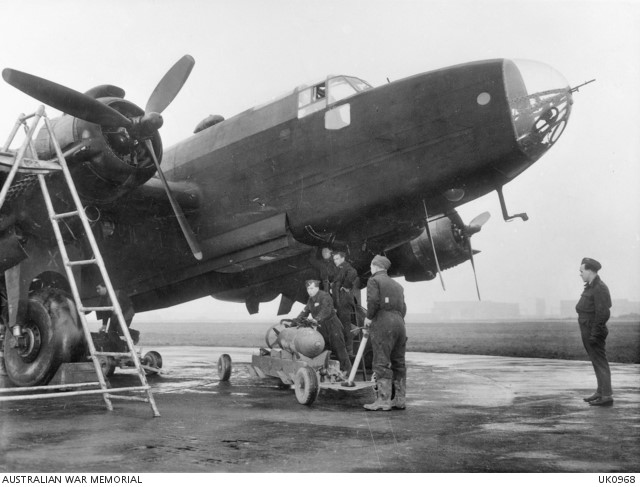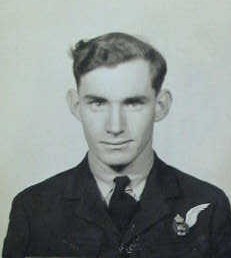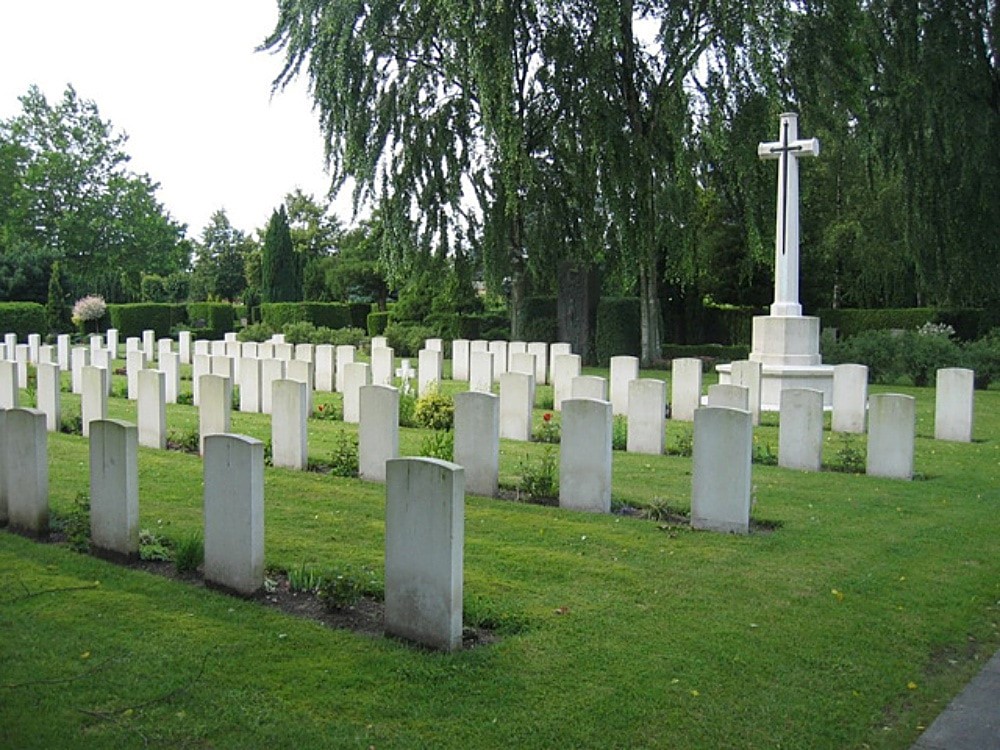Flight Sergeant Keith Courtney Donald, the son of James Stirling Donald and Mary Clare Donald (nee Hutchinson), was born at Townsville on 30th March 1923. He was educated at the East State School in Toowoomba where he passed the State Scholarship examination. He was a day student at the Toowoomba Grammar School between January 1938 and April 1939. He then attended the Townsville Grammar School where he passed the Junior Public Examination in 1939. After leaving school, he was employed as a Junior Clerk at the Standply Timber Company at Cardwell in North Queensland. Whilst a student, he had served for 2 years in the Toowoomba Grammar and Townsville Grammar cadet units. He applied for aircrew training in the Royal Australian Air Force on 16th January 1942. He was enrolled in the Reserve of the R.A.A.F, on 22nd April 1942 after swearing an oath of affirmation and issued Reserve Badge No. 5649.
Flight Sergeant Keith Donald at the age of 19 years and 1 month was enlisted into the Citizen Air Force of the R.A.A.F. at No. 3 Recruiting Centre in Brisbane on 25th May 1942 after giving an undertaking that he would serve for the duration of the war and an additional twelve months. At the time of his enlistment he was unmarried and employed as a Clerk. His physical description at the time of his enlistment was that he was 5 feet 7 inches in height and weighed 135 pounds. He had a fair complexion, blue eyes and dark brown hair. He gave his next of kin as his father, Mr James Donald, residing at 6 Hubert Street in Townsville. He stated that he was of the Roman Catholic religion. He was allotted the service number of 426265. He also gave Mrs H. Neighbour, 1560 Pacific Avenue, Winnipeg, Manitoba, Canada, as a person to be advised in the event of his injury or death.
Flight Sergeant Keith Donald joined No. 3 Recruit Depot at Maryborough in Queensland on 26th May 1942 where he completed basic recruit training. He joined Headquarters R.A.A.F. Station Amberley on 21st June 1942 as aircrew (guard). He was transferred to No. 3 Aircraft Depot at Amberley on 12th August 1942. He joined No. 3 Initial Training School at Kingaroy in Queensland on 11th October 1942 where he was selected as a student for an eight week course of instruction to prepare him for employment as an Air Gunner. He joined No. 2 Embarkation Depot at Bradfield Park in Sydney on 5th December 1942 and then transferred to No. 1 Embarkation Depot at Ascot Vale in Victoria on 9th January 1943 in preparation for movement overseas on attachment to the Royal Canadian Air Force for further training.
He embarked from Melbourne in Victoria on 15th January 1943 and disembarked in Canada on 31st January 1943 where he joined No. 3 Manning Depot. He joined No. 3 Wireless School at Winnipeg in Manitoba on 20th February 1943. He joined No. 8 Bombing & Gunnery School at Lethbridge in Alberta on 3rd September 1943. He qualified as an Air Gunner and was promoted to the rank of Temporary Sergeant on 18th October 1943. He joined No. 1 “Y” Depot at Halifax in Nova Scotia on 29th October 1943 to prepare for overseas service on attachment to the Royal Air Force. He embarked from Canada on 1st November 1943 and he disembarked in England on 10th November 1943 and later that day joined No. 11 Personnel Despatch & Reception Centre at Brighton. He joined No. 2 (Observer) Advanced Flying Unit at Millam in Cumberland on 29th February 1944. He joined No. 10 Operational Training Unit at Royal Air Force Station Stanton Harcourt on 11th April 1944. He was promoted to the rank of Temporary Flight Sergeant on 18th April 1944. He joined No. 41 Base at Royal Air Force Station Marston Moor on 30th June 1944. He joined No. 466 Squadron Royal Australian Air Force for operational duty on 17th August 1944
Flight Sergeant Keith Donald was a Wireless Operator and member of the crew of a No. 466 Squadron Royal Australian Air Force Halifax Bomber MZ915 that left its base at Royal Air Force Station Driffield to attack a target at Keil in Germany that crashed at Osterholm in Denmark on the 15th/16th September 1944.

Australian War Memorial photograph UK0968
Ground crew bombing up a Halifax aircraft of No. 466 Squadron for a raid on Berlin.
His father was notified by telegram that he was missing on air operations on 21st September 1944. Group Captain Forsyth, Officer Commanding No. 466 Squadron sent the following letter to Keith Donald’s father on 17th September 1944:
Before you receive this letter, you will have been notified by the Air Board, Melbourne, that your son, Flight Sergeant Keith Courtney Donald, was reported missing from an operational flight from this country. It is with deep regret that I am writing to confirm this unhappy news and to convey to you the heartfelt sympathy of the Squadron in your great anxiety.
The aircraft, in which your son was Wireless Operator, took off to carry out an attack on enemy territory, but unfortunately it did not return. This flight was one of those great efforts called for from the Royal Australian Air Force, which we all hope have contributed enormously to the shortening of the war. It was undertaken with resolution and efficiency, so typical of your son and his crew. They set an example on the Squadron during the short time that they were with us, which was an inspiration to all. The most searching enquiries through all possible channels have so far revealed nothing, but naturally it will take some time for possible information to reach this country from enemy sources. Meanwhile we can only hope that Flight Sergeant Donald and the other members of his crew are prisoners of war. May I express my personal sympathy and profound regret that it should fall to my lot to convey to you tidings such as these knowing as I do what an anxious time it will mean to you. Yours sincerely.
Subsequent information received from German sources by the International Red Cross Committee confirmed that five members of the crew were confirmed dead however nothing was revealed as to the fate of Keith Donald and another member of the crew. The five identified members were buried in the Apenrade Cemetery 10 miles north of Flensburg, Denmark.
On 15th June 1945 Keith Donald’s father was advised of the following by the Casualty Section:
A report has not been received that Danish citizens state that your son’s Halifax aircraft collided with another Halifax aircraft apparently after being damaged by enemy action on the island of Alsen, Denmark, and the wreckage of both aircraft was scattered over a wide area. All members of both aircraft are believed to have been buried in the cemetery at Apenrade in the province of North Schleswig, Denmark. Apenrade is sometimes spelt Aabenren and may in some maps be shown as being in Germany as this territory was for a time annexed by Germany. Investigations in order to obtain more precise burial details are in progress and you will be notified of the result.
In September 1946 No. 18 Section of the Missing Research & Enquiry Service exhumed the bodies in the cemetery and another two that had been buried in a wood near Norreskev. As a result of the exhumation of the bodies it was possible to positively identify 9 members of the two aircraft and they were reburied in individual graves. It was not possible to identify the remains of Keith Donald and four others therefore they were buried in a communal grave alongside the graves of those that were identified in the Aabenraa Cemetery, Denmark.
For his service during World War 2, Keith Donald qualified for the Air Gunners Badge, the 1939/1945 Star, the France & Germany Star, the Defence Medal, the War Medal and the Australian Service Medal 1939/1945. Keith Donald’s name is commemorated on Panel No. 110 at the Australian War Memorial in Canberra and locally on the Toowoomba Grammar School World War 2 Honour Board.
The following newspaper report appeared in the Townsville Daily Bulletin on 10th October 1944:
“PERSONAL – Word has been received by Mr and Mrs J.S. Donald, 6 Hubert Street, South Townsville, that their second son, Flight Sergeant Keith Courtney Donald, has been reported missing after an operational flight in the European area. Keith was of a cheery temperament, just 21 years of age, and had marked success in his examinations in Canada and England under the Empire Training Scheme. Flight Sergeant Donald received his education at the Toowoomba and Townsville Grammar Schools. An enthusiastic footballer, he played with the Estates football club, and at date of enlistment was employed in the office of Standply Ltd., Kennedy. The Donald family have their only three sons in the fighting forces.”
The following newspaper report appeared in the Townsville Daily Bulletin on 27th February 1947:
DENMARK HONORS ITS LIBERATORS – Through a Danish publication, “They Died For Us,” Mr and Mrs J. Donald of Hubert Street, South Townsville, have discovered the burial place of their son, Keith Courtney Donald, who was killed in September 1944 in a collision between two Halifax bombers over the island of Als, off South Jutland. The publication which is printed in memory of Allied airmen who lost their lives in Denmark during the Second World War, pays a fine tribute to the memory of the men who lost their lives in this disaster.
Keith Donald wireless operator, and Clive Thomson of Melbourne navigator, were the only Australians in the crew of seven in one of these machines which had completed a bombing raid on Kiel. Wave after wave of bombers passed over Als on that night of September 16.
Now in Norreskoven on that little fertile island Als, off the east coast of South Jutland, an attractive stone bearing the short inscription “R.A.F. 16-9-44,” marks the resting place of three of these British airmen in a glade in the very middle of an extensive forest of beech trees. This lonely grave the publication states is always adorned with fresh flowers and the inhabitants of Als regularly wend their way to the grave in order to honour the memory of the fallen airmen in this manner.
The fact that more than 2600 Allied soldiers and airmen were buried in Denmark during the second major conflict is astounding when it is considered that only in the first days of the occupation and the last days of the war Denmark could be called an actual battle area. Together with her own fallen, Denmark now honours and reveres the memory of these Allied soldiers and airmen now resting in Danish soil.
An organisation was formed whereby fares have been paid from England for the parents of these men to visit the resting place of those held dear to them.




